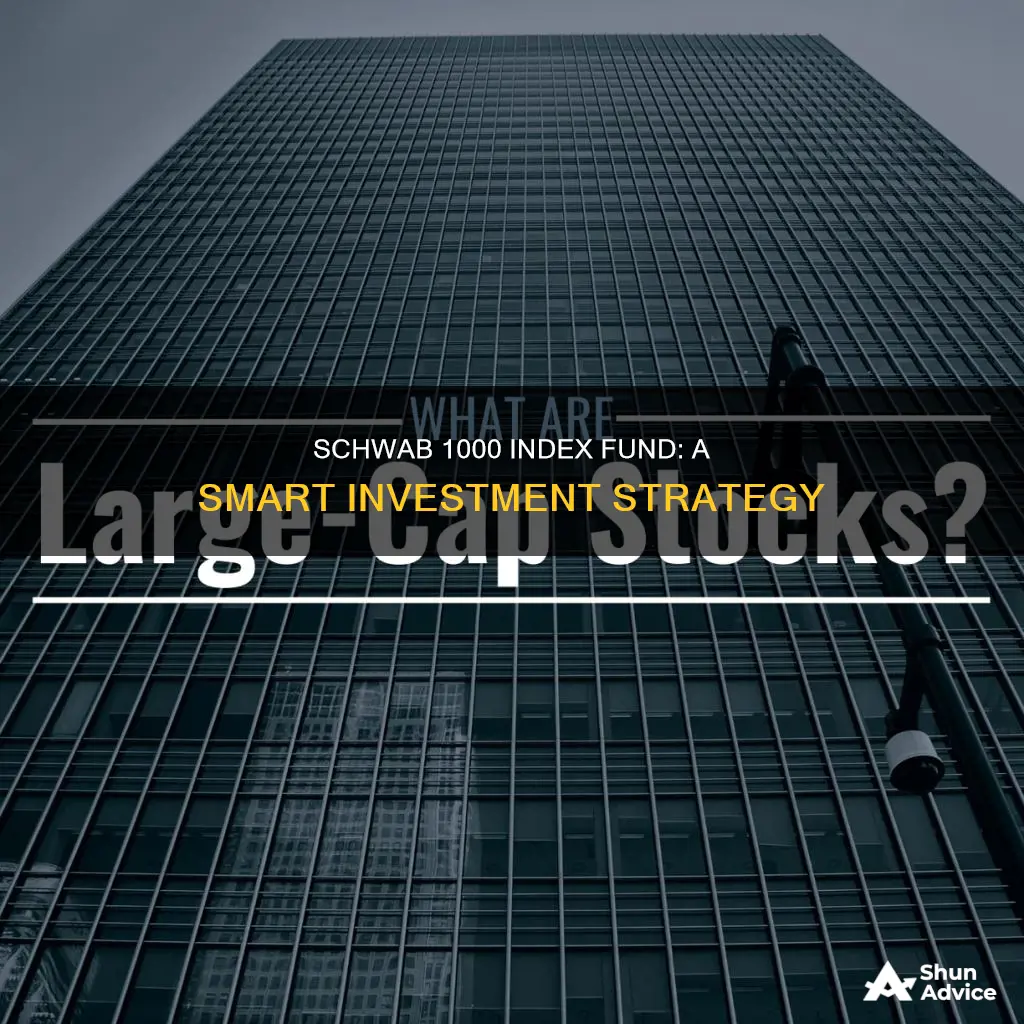
The Schwab 1000 Index Fund is a large-blend fund that tracks the performance of the Schwab 1000 Index, which includes the 1,000 largest US companies by market capitalization. The fund was launched in April 1991 and has since grown to hold almost $13.49 billion in assets as of November 27, 2023. With an expense ratio of just 0.05%, the fund offers a low-cost way for investors to gain exposure to a diversified portfolio of large- and mid-cap US stocks. As of 2024, the fund's largest holdings include well-known companies such as Apple, Microsoft, Amazon, and Meta Platforms Inc.
| Characteristics | Values |
|---|---|
| Type | Mutual Fund |
| Symbol | SNXFX |
| Total Expense Ratio | 0.050% |
| Investment Style | Large Blend |
| Minimum Initial Investment | $0 |
| Total Assets | $17.5 billion |
| Distribution Fee Level | Low |
| Share Class Type | No Load |
| Holdings | Apple, Microsoft, Amazon, Johnson & Johnson, Facebook, Meta Platforms Inc Class A, Alphabet Inc Class A, Berkshire Hathaway Inc Class B, Alphabet Inc Class C |
What You'll Learn

Low fees and no minimum investment
The Schwab 1000 Index Fund is a straightforward, low-cost fund with no minimum investment. The fund's expense ratio is an ultra-low 0.05% with no 12b-1 fees or minimum investment. This means that investors can access the fund with any amount of money and not have to worry about high fees eating into their returns.
The fund's low fees are made possible by its passive management style. Instead of actively picking stocks, the fund simply tracks the Schwab 1000 Index, a proprietary index of the 1,000 largest US stocks by market capitalization. This rules-based approach means that the fund can be managed with minimal intervention from investment professionals, keeping costs low.
The absence of a minimum investment makes the fund accessible to a wide range of investors. Whether an individual has $100 or $100,000 to invest, they can get started with the Schwab 1000 Index Fund. This flexibility can be especially beneficial for new investors who may not have a large sum of money to invest upfront.
In addition to the fund's low fees, investors can also benefit from low commission rates when trading with Schwab. Commission rates start at $0 for US-listed stocks and ETFs, making it even more affordable for investors to build and maintain a diversified portfolio.
Overall, the low fees and no minimum investment associated with the Schwab 1000 Index Fund make it an attractive option for cost-conscious investors who want to access a diversified portfolio of large-cap US stocks without having to worry about high upfront costs or ongoing expenses.
Vanguard Funds: Smart HSA Investment Strategies
You may want to see also

Above-average returns
The Schwab 1000 Index Fund has delivered above-average returns for investors over the past three and ten years compared to other funds in the large-blend peer group. As of 2017, the fund had returned 9.35% over the past year, 9.24% over the past three years, 10.49% over the past five years, and 10.64% over the past decade.
The fund's performance is impressive, considering it has a low expense ratio of 0.05% and no 12b-1 fees or minimum investment. This means that investors can access a diverse range of large- and mid-cap U.S. stocks with minimal fees. The fund's largest holdings include well-known companies such as Apple, Microsoft, Amazon, Johnson & Johnson, and Facebook, which have likely driven its strong performance.
The fund's above-average returns can also be attributed to its disciplined, rules-based approach to ranking the largest U.S. stocks by market capitalization. This strategy ensures that the fund maintains a well-diversified portfolio of established companies, which has contributed to its long-term success.
Additionally, the fund's parent company, Charles Schwab, is one of the largest brokerage and financial services firms in the country. Their expertise and resources have likely contributed to the fund's strong performance and ability to deliver above-average returns.
Overall, the Schwab 1000 Index Fund's above-average returns make it an attractive investment option for those seeking exposure to a diverse range of large U.S. companies with a proven track record of success.
Pension Funds: Where Are Government Investments Directed?
You may want to see also

Large-cap and mid-cap stocks
The Schwab 1000 Index Fund is a passively managed index fund that tracks the performance of the Schwab 1000 Index, a proprietary index of large- and mid-cap U.S. stocks. The fund was launched in April 1991 by Charles Schwab, the founder of one of the largest brokerage and financial services firms in the country.
The fund seeks to provide investors with a simple and low-cost way to invest in the 1,000 largest U.S. companies by market capitalization, covering approximately 90% or more of the total U.S. stock market capitalization. As of November 27, 2023, the fund had assets totaling nearly $13.49 billion invested in 999 different holdings, with its largest holdings in well-known companies such as Apple, Microsoft, Amazon, Johnson & Johnson, and Meta Platforms Inc.
The Schwab 1000 Index Fund offers a diversified portfolio of large- and mid-cap stocks, providing investors with exposure to a broad range of established and well-known companies across various sectors. Large-cap stocks, or stocks of companies with a market capitalization of $10 billion or more, tend to be more stable and established companies with a strong track record of financial performance. These companies often have a dominant market position, strong brand recognition, and a global presence. Investing in large-cap stocks can provide a relatively lower-risk investment option, as these companies typically have a long history of stable financial performance and are less volatile than smaller-cap stocks.
Mid-cap stocks, on the other hand, are stocks of companies with a market capitalization between $2 billion and $10 billion. These companies are typically smaller than those in the large-cap category but are still well-established and have a strong presence in their respective industries. Mid-cap stocks often offer a balance between the stability of large-cap stocks and the growth potential of small-cap stocks. They can provide investors with the opportunity to benefit from the growth and expansion of these companies, while still offering a relatively lower risk compared to small-cap stocks.
By investing in the Schwab 1000 Index Fund, investors can gain access to a diversified portfolio of large- and mid-cap stocks, providing exposure to some of the largest and most well-known companies in the U.S. market. This fund offers a straightforward and low-cost investment option, with an ultra-low expense ratio of 0.05% and no minimum investment requirement. The fund's performance has been strong, with returns of 9.35% over the past year, 9.24% over the past three years, 10.49% over the past five years, and 10.64% over the past decade.
Provident Fund Money: Where is it Invested?
You may want to see also

Low-risk
The Schwab 1000 Index Fund is a large-blend fund that tracks the Schwab 1000 Index, which consists of the 1,000 largest US stocks by market capitalisation. The fund itself invests at least 80% of its assets in stocks included in the index. As of November 27, 2023, the fund had almost $13.49 billion in assets spread across 999 different holdings.
The fund is considered a low-risk investment option for several reasons. Firstly, it has an ultra-low expense ratio of 0.05% with no 12b-1 fees or minimum investment. This means that investors can access a diversified portfolio of large-cap stocks with minimal fees, reducing the overall cost of investing. Secondly, the fund's performance has been relatively stable compared to other funds in its peer group. Morningstar, a leading investment research firm, has rated the fund's risk as average compared to other large-blend funds over the trailing three-, five-, and ten-year periods. While past performance does not guarantee future results, the fund has consistently delivered returns above or in line with its peers over these periods.
Additionally, the fund's diversified nature helps to mitigate risk. By investing in a broad range of large-cap stocks, the fund reduces the impact of individual stock volatility on the overall portfolio. As of June 30, 2017, the fund's holdings were well-diversified across different sectors and market capitalisations, closely mirroring the composition of its benchmark index, the Russell 1000. This diversification helps to lower the overall risk of the investment.
The fund's investment strategy also contributes to its low-risk profile. As a passively managed index fund, it seeks to replicate the performance of the Schwab 1000 Index rather than actively picking stocks. This disciplined, rules-based approach ranks stocks based on market capitalisation, providing exposure to a diverse set of established companies. The fund's largest holdings include well-known, established companies such as Apple, Microsoft, Amazon, and Meta Platforms (formerly Facebook).
Overall, the Schwab 1000 Index Fund offers a low-risk investment option for those seeking broad exposure to the largest US companies. With its low fees, diversified portfolio, and stable performance history, the fund provides a relatively safe way to participate in the growth of the US economy and stock market.
NHCU's Investment Strategies: Where Are Funds Allocated?
You may want to see also

Long history of performance
The Schwab 1000 Index Fund has a long history of performance, dating back to its inception in April 1991. Over the past decade, the fund has returned 10.64%, with returns of 9.35% over the past year, 9.24% over three years, and 10.49% over five years. As of November 27, 2023, the fund had assets totalling almost $13.49 billion invested in 999 different holdings.
The fund's performance can be attributed to its disciplined, rules-based approach that ranks the largest U.S. stocks based on market capitalization. It provides exposure to the 1,000 largest publicly traded U.S. companies, covering approximately 90% or more of the total U.S. stock market capitalization. The fund's largest holdings include well-known companies such as Apple, Microsoft, Amazon, Johnson & Johnson, and Meta Platforms Inc.
The fund has consistently performed well, placing in the top 30th percentile for the trailing three years, and the 28th percentile for the trailing five and ten years as of early September 2017. The fund's risk is considered average when compared to other funds in the large-blend peer group, while the level of return is above average for the trailing three and ten-year periods and average for the trailing five years.
The Schwab 1000 Index Fund's long history of performance can be attributed to its passive management style, low expense ratio of 0.05%, and diverse portfolio of large- and mid-cap U.S. stocks. The fund's parent company, Charles Schwab, is also a major financial services firm and one of the largest brokerage firms in the country, offering a wide range of investment products for investors.
Vanguard Traditional IRA: Best Funds for Your Retirement Savings
You may want to see also
Frequently asked questions
The Schwab 1000 Index Fund is a straightforward, low-cost fund with no investment minimum that tracks the Schwab 1000 Index. The fund's goal is to match the total return of the Schwab 1000 Index, which is a proprietary index of large- and mid-cap U.S. stocks comprising the 1,000 largest stocks by market capitalization.
The fund has a low expense ratio of 0.05% and no 12b-1 fees or minimum investment. It covers approximately 90% or more of the total U.S. stock market capitalization, providing access to the 1,000 largest publicly traded U.S. companies. The fund has a long history of performance, having been launched in April 1991, and has returned 9.35% over the past year, 9.24% over the past three years, 10.49% over the past five years, and 10.64% over the past decade.
As with any investment in equities, there is a risk of losing value based on a variety of factors. The fund's risk is tied to the performance of the underlying index and the performance of large- and mid-cap domestic stocks.







